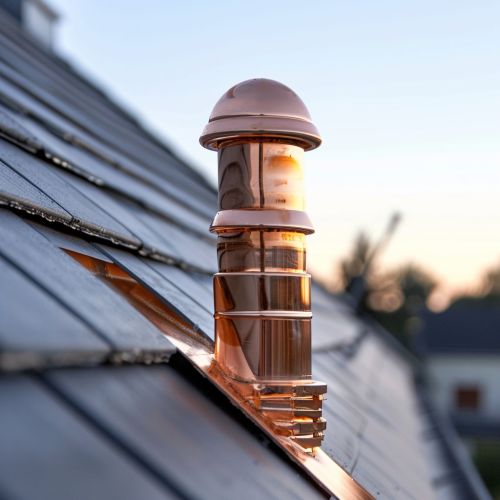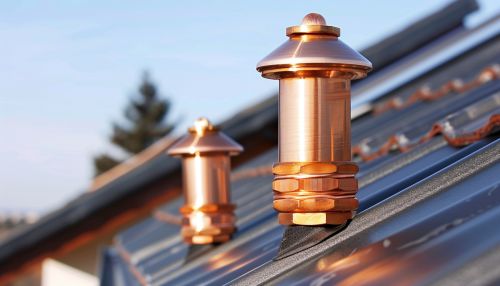Lightning rod: Difference between revisions
(Created page with "== Introduction == A lightning rod is a metal rod or conductor mounted on top of a building and connected to the ground through a wire, designed to protect the structure from lightning strikes. When a lightning strike occurs, the rod provides a low-resistance path for the electrical discharge to travel to the ground, thereby preventing damage to the building. The concept of the lightning rod was first introduced by Benjamin Franklin in the 18th century, and it h...") |
No edit summary |
||
| (One intermediate revision by the same user not shown) | |||
| Line 11: | Line 11: | ||
Modern lightning rods are typically made of highly conductive materials such as copper or aluminum. These materials are chosen for their ability to conduct electricity efficiently and withstand the high temperatures generated by a lightning strike. The rod is usually pointed at the top to facilitate the ionization of the surrounding air, which helps to attract the lightning strike. The rod is connected to a grounding system through a series of conductors, which are designed to carry the electrical discharge safely to the ground. | Modern lightning rods are typically made of highly conductive materials such as copper or aluminum. These materials are chosen for their ability to conduct electricity efficiently and withstand the high temperatures generated by a lightning strike. The rod is usually pointed at the top to facilitate the ionization of the surrounding air, which helps to attract the lightning strike. The rod is connected to a grounding system through a series of conductors, which are designed to carry the electrical discharge safely to the ground. | ||
[[Image:Detail-79551.jpg|thumb|center|A copper lightning rod installed on the roof of a building, with a clear sky in the background.|class=only_on_mobile]] | |||
[[Image:Detail-79552.jpg|thumb|center|A copper lightning rod installed on the roof of a building, with a clear sky in the background.|class=only_on_desktop]] | |||
== Installation and Maintenance == | == Installation and Maintenance == | ||
Latest revision as of 22:47, 18 May 2024
Introduction
A lightning rod is a metal rod or conductor mounted on top of a building and connected to the ground through a wire, designed to protect the structure from lightning strikes. When a lightning strike occurs, the rod provides a low-resistance path for the electrical discharge to travel to the ground, thereby preventing damage to the building. The concept of the lightning rod was first introduced by Benjamin Franklin in the 18th century, and it has since become a critical component in the field of electrical engineering and building safety.
History
The invention of the lightning rod is attributed to Benjamin Franklin, who conducted his famous kite experiment in 1752. Franklin's experiment demonstrated that lightning is a form of electricity, and he proposed the use of metal rods to protect buildings from lightning strikes. The first lightning rods were simple metal rods attached to the highest point of a building, connected to the ground by a wire. Over time, the design and materials used for lightning rods have evolved, but the basic principle remains the same.
Design and Materials
Modern lightning rods are typically made of highly conductive materials such as copper or aluminum. These materials are chosen for their ability to conduct electricity efficiently and withstand the high temperatures generated by a lightning strike. The rod is usually pointed at the top to facilitate the ionization of the surrounding air, which helps to attract the lightning strike. The rod is connected to a grounding system through a series of conductors, which are designed to carry the electrical discharge safely to the ground.


Installation and Maintenance
Proper installation of a lightning rod system is crucial for its effectiveness. The rod should be installed at the highest point of the structure and connected to a grounding system that meets local electrical codes and standards. The grounding system typically consists of one or more ground rods driven into the earth, connected to the lightning rod by heavy-gauge conductors. Regular maintenance is also important to ensure that the system remains in good working condition. This includes inspecting the rod and conductors for signs of corrosion or damage and ensuring that the grounding system remains effective.
Mechanism of Action
When a lightning strike occurs, the electrical discharge seeks the path of least resistance to the ground. The lightning rod provides this path, allowing the electrical current to flow safely through the rod and conductors to the ground. This prevents the electrical energy from passing through the building's structure, where it could cause fires, electrical surges, or other forms of damage. The pointed tip of the rod helps to ionize the surrounding air, creating a conductive path for the lightning to follow.
Applications
Lightning rods are used to protect a wide range of structures, including residential homes, commercial buildings, industrial facilities, and even outdoor structures such as communication towers and wind turbines. In addition to protecting buildings, lightning rods are also used to safeguard sensitive equipment and infrastructure, such as power lines and pipelines. The principles of lightning protection are also applied in the design of aircraft and spacecraft, which are exposed to lightning strikes during flight.
Advances in Lightning Protection
Recent advances in lightning protection technology have led to the development of more sophisticated systems, such as early streamer emission (ESE) lightning rods and charge transfer systems (CTS). ESE lightning rods are designed to emit a stream of ions that attract the lightning strike, providing a larger area of protection. CTS systems work by reducing the electrical charge buildup in the protected area, thereby reducing the likelihood of a lightning strike. These advanced systems are often used in high-risk environments where traditional lightning rods may not provide sufficient protection.
Safety and Standards
The installation and maintenance of lightning protection systems are governed by various national and international standards, such as the National Fire Protection Association (NFPA) 780 standard in the United States and the International Electrotechnical Commission (IEC) 62305 standard. These standards provide guidelines for the design, installation, and maintenance of lightning protection systems to ensure their effectiveness and safety. Compliance with these standards is essential for minimizing the risk of lightning-related damage and ensuring the safety of the protected structure and its occupants.
